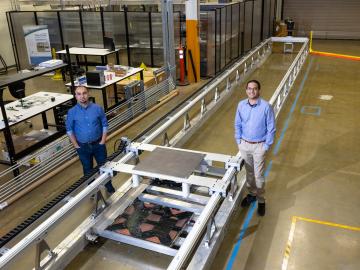
Filter News
Area of Research
- (-) Energy Science (107)
- Advanced Manufacturing (10)
- Biological Systems (1)
- Biology and Environment (100)
- Biology and Soft Matter (1)
- Fusion and Fission (7)
- Fusion Energy (1)
- Isotopes (3)
- Materials (82)
- Materials Characterization (2)
- Materials for Computing (7)
- Materials Under Extremes (1)
- National Security (12)
- Neutron Science (23)
- Nuclear Science and Technology (5)
- Quantum information Science (1)
- Supercomputing (58)
News Type
News Topics
- (-) 3-D Printing/Advanced Manufacturing (51)
- (-) Bioenergy (24)
- (-) Environment (31)
- (-) Exascale Computing (2)
- (-) Materials (22)
- Advanced Reactors (5)
- Artificial Intelligence (6)
- Big Data (1)
- Biology (9)
- Biomedical (5)
- Biotechnology (3)
- Buildings (19)
- Chemical Sciences (13)
- Clean Water (4)
- Composites (7)
- Computer Science (16)
- Coronavirus (9)
- Critical Materials (4)
- Cybersecurity (8)
- Energy Storage (46)
- Fossil Energy (2)
- Frontier (1)
- Fusion (1)
- Grid (22)
- High-Performance Computing (4)
- Hydropower (1)
- Isotopes (1)
- Machine Learning (4)
- Materials Science (15)
- Mathematics (1)
- Mercury (2)
- Microelectronics (1)
- Microscopy (6)
- Molten Salt (1)
- Nanotechnology (7)
- National Security (5)
- Neutron Science (9)
- Nuclear Energy (6)
- Partnerships (12)
- Physics (1)
- Polymers (6)
- Quantum Science (2)
- Security (6)
- Simulation (2)
- Space Exploration (1)
- Summit (4)
- Transportation (34)
Media Contacts

ORNL’s Zhenglong Li led a team tasked with improving the current technique for converting ethanol to C3+ olefins and demonstrated a unique composite catalyst that upends current practice and drives down costs. The research was published in ACS Catalysis.

Consumer buy-in is key to the future of a decarbonized transportation sector in which electric vehicles largely replace today’s conventionally fueled cars and trucks.

Through a consortium of Department of Energy national laboratories, ORNL scientists are applying their expertise to provide solutions that enable the commercialization of emission-free hydrogen fuel cell technology for heavy-duty

Oak Ridge National Laboratory was among an international team, led by Lawrence Livermore National Laboratory, who synthesized 108 elevated carbon dioxide, or CO2, experiments performed in various ecosystems to find out how much carbon is

Xin Sun has been selected as the associate laboratory director for the Energy Science and Technology Directorate, or ESTD, at the Department of Energy’s Oak Ridge National Laboratory.

Twenty-seven ORNL researchers Zoomed into 11 middle schools across Tennessee during the annual Engineers Week in February. East Tennessee schools throughout Oak Ridge and Roane, Sevier, Blount and Loudon counties participated, with three West Tennessee schools joining in.

Three technologies developed by ORNL researchers have won National Technology Transfer Awards from the Federal Laboratory Consortium. One of the awards went to a team that adapted melt-blowing capabilities at DOE’s Carbon Fiber Technology Facility to enable the production of filter material for N95 masks in the fight against COVID-19.

The ExOne Company, the global leader in industrial sand and metal 3D printers using binder jetting technology, announced it has reached a commercial license agreement with Oak Ridge National Laboratory to 3D print parts in aluminum-infiltrated boron carbide.

Six scientists at the Department of Energy’s Oak Ridge National Laboratory were named Battelle Distinguished Inventors, in recognition of obtaining 14 or more patents during their careers at the lab.

As ORNL’s fuel properties technical lead for the U.S. Department of Energy’s Co-Optimization of Fuel and Engines, or Co-Optima, initiative, Jim Szybist has been on a quest for the past few years to identify the most significant indicators for predicting how a fuel will perform in engines designed for light-duty vehicles such as passenger cars and pickup trucks.


